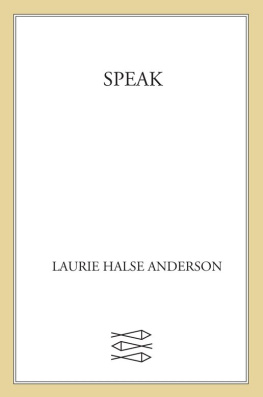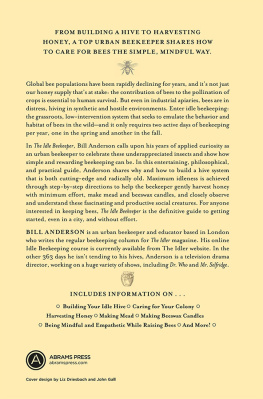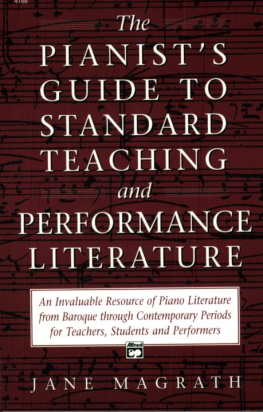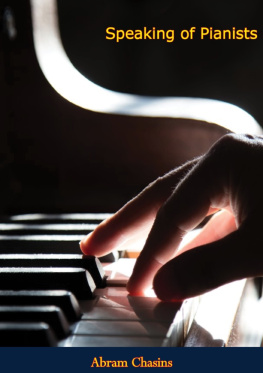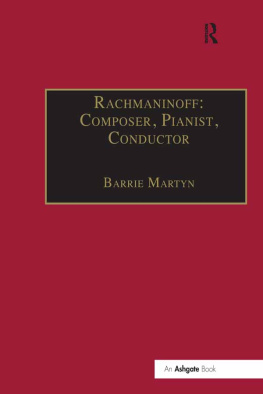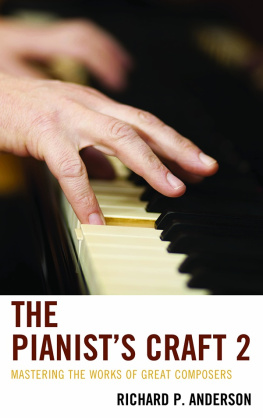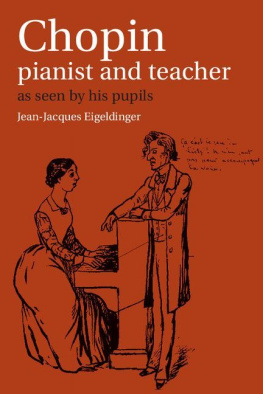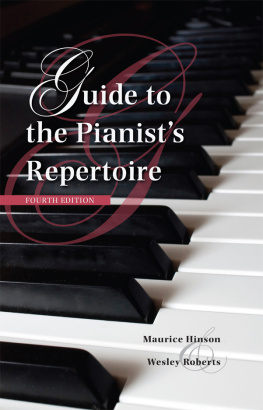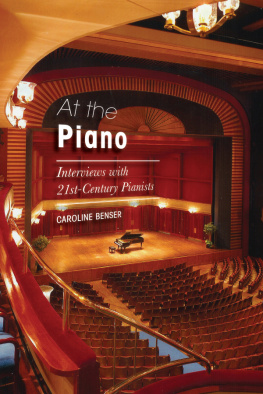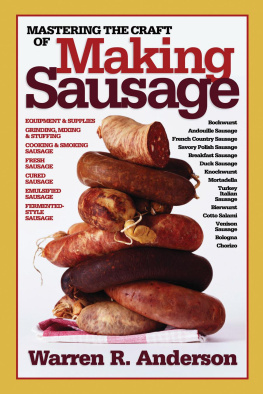Anderson - The pianist’s craft : mastering the works of great composers
Here you can read online Anderson - The pianist’s craft : mastering the works of great composers full text of the book (entire story) in english for free. Download pdf and epub, get meaning, cover and reviews about this ebook. City: Lanham, Md., year: 2012, publisher: Scarecrow Press, genre: Children. Description of the work, (preface) as well as reviews are available. Best literature library LitArk.com created for fans of good reading and offers a wide selection of genres:
Romance novel
Science fiction
Adventure
Detective
Science
History
Home and family
Prose
Art
Politics
Computer
Non-fiction
Religion
Business
Children
Humor
Choose a favorite category and find really read worthwhile books. Enjoy immersion in the world of imagination, feel the emotions of the characters or learn something new for yourself, make an fascinating discovery.

The pianist’s craft : mastering the works of great composers: summary, description and annotation
We offer to read an annotation, description, summary or preface (depends on what the author of the book "The pianist’s craft : mastering the works of great composers" wrote himself). If you haven't found the necessary information about the book — write in the comments, we will try to find it.
The pianist’s craft : mastering the works of great composers — read online for free the complete book (whole text) full work
Below is the text of the book, divided by pages. System saving the place of the last page read, allows you to conveniently read the book "The pianist’s craft : mastering the works of great composers" online for free, without having to search again every time where you left off. Put a bookmark, and you can go to the page where you finished reading at any time.
Font size:
Interval:
Bookmark:
The Pianists Craft
Mastering the Works of Great Composers
Edited by Richard Paul Anderson
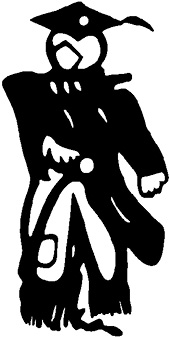
THE SCARECROW PRESS, INC.
Lanham Toronto Plymouth, UK
2012
Published by Scarecrow Press, Inc.
A wholly owned subsidiary of The Rowman & Littlefield Publishing Group, Inc.
4501 Forbes Boulevard, Suite 200, Lanham, Maryland 20706
http://www.scarecrowpress.com
Estover Road, Plymouth PL6 7PY, United Kingdom
Copyright 2012 by Richard Paul Anderson
All rights reserved . No part of this book may be reproduced in any form or by any electronic or mechanical means, including information storage and retrieval systems, without written permission from the publisher, except by a reviewer who may quote passages in a review.
British Library Cataloguing in Publication Information Available
Library of Congress Cataloging-in-Publication Data
The pianists craft : mastering the works of great composers / edited by Richard
Paul Anderson.
p. cm.
Includes bibliographical references and index.
ISBN 978-0-8108-8205-8 (cloth : alk. paper) ISBN 978-0-8108-8206-5
(ebook)
1. PianoPerformance. I. Anderson, Richard P.
ML700.P53 2012
786.2'143dc23 2011030336
 The paper used in this publication meets the minimum requirements of American National Standard for Information SciencesPermanence of Paper for Printed Library Materials, ANSI/NISO Z39.48-1992.
The paper used in this publication meets the minimum requirements of American National Standard for Information SciencesPermanence of Paper for Printed Library Materials, ANSI/NISO Z39.48-1992.
Printed in the United States of America
To Susan
Acknowledgments
I would like to thank each of the authors for their tireless work, and for the dedication and love of their profession and subject matter that is evidenced in each chapter. Appreciation also goes to Zachary Van Houten and Joseph Sowa for their excellent transcriptions of the examples, to Britny Clark for her assistance in obtaining the copyright permissions and proofreading musical examples, to Charles Stratford and Ruth Eldredge for their invaluable assistance in formatting and editing, and to Doug Bush for his translation from German to English of Inge Rosars article on Bach.
Introduction
To put it squarely, the problem is one, not of the piano, but of the pianist.
Very well, my dear... you continue to play Bach your way and Ill continue to play him his way.
The pianists profession is a daunting one. I have found after nearly forty years of teaching that each succeeding year has increased my appreciation for how vast and varied the subject of piano literature and its performance is. When you ponder all of the physical, mental, aural, and emotional complexities involved in the preparation and performance of a work for piano, it truly is an awe-inspiring event, regardless of the age or experience of the pianist.
Even though our task might seem intimidating, we pianists love the challenge. We utilize all types of resources: books, periodicals, conferences, recordings, live concerts, and others. We steep ourselves in the rich history of the keyboards development. We study the lives of composers to determine what influences affected their writing. We seek to understand the differences of the style periods. Then we approach the technical, stylistic, and interpretive challenges so we can infuse the music with all the emotional and spiritual inspiration possible. All of this, we hope, will culminate in a performance that reflects something of what the composer intended to be communicated to the audience. More often than not, the end result is more fulfilling than we anticipated.
Our task is also humbling. Regardless of our experience, we know our approach to the repertoire must always evolve. And this includes mastering not only the works of the past, but also the new works that continue to come forth and deserve, even demand, a place in our repertoire.
I am blessed to work with wonderful and exceptionally talented colleagues. We frequently share our thoughts concerning these challenges that are so unique to the pianist. One of these discussions led me to the idea of compiling and publishing a collection of essays written by successful artists and teachers who have established themselves nationally and internationally, who have been in the trenches and understand the challenges. The emphasis of the essays would be on how to prepare, teach, and perform works by composers about whom the contributors are particularly knowledgeable and enthusiastic. Such a collection would seem to be a valuable resource for students, teachers, and performers.
I began contacting influential pianists about the project, most of whom I did not know, but who now have become friends and colleagues. Their responses were overwhelmingly positive and enthusiastic. As they began to submit their chapters, I found their topics to be varied and fascinating, addressing such issues:
- How should ornamentation and articulation in Haydns music be approached?
- In what ways did Ravels Erard piano differ from modern keyboards? How did the physical characteristics of his keyboard affect the way he composed, and how should these influences affect the way his works are performed on modern keyboards?
- How does a pianist achieve the singing tone and sonorous sound required in the works of Chopin?
- What is the role of rubato in the piano works of Brahms? How does his displacement of the beat affect the rhythmic movement? What role do thumbs play when voicing his lyrical lines?
- How does one decipher Liszts fascination with color and gesture and transfer it to the keyboard?
- What is the connection of fire and light with the works of Scriabin?
- What role does lyricism play in Prokofievs piano works, even those that are the most percussive?
- Is there a way to master the scores and performance demands of Crumb so that his works seem less daunting?
This book is not meant to be comprehensive, nor does it restrict each article to a predetermined format. Rather than constrain the authors to observe the same academic pigeon holes, I felt it would be far more interesting and diverse if the authors were allowed the freedom to draw on their varied and unique experience and expertise. This flexibility has produced chapters that I hope will illuminate, inspire, and motivate pianists to delve more deeply into the lives and works of the composers represented in this volume.
Notes
1. Willi Apel, Masters of the Keyboard (London: Oxford University Press, 1970), 5.
2. Overheard from Wanda Landowska and quoted in Harold C. Schonberg, The Great Pianists (New York: Simon and Schuster, 1987), 422.
Performing Scarlatti
Hilary Demske
Of all the major 18th-century composers Scarlatti remains surely the most enigmatic.
Kenneth Gilberts statement addresses the unusual juxtaposition of acclaim and uncertainty that surrounds Domenico Scarlatti. Although Scarlatti occupies an essential part of the pianists repertoire, a lack of historical information about his life has resulted in conflicting approaches to his music. As an Italian living in Spain, Scarlatti was undoubtedly exposed to a variety of musical styles, but a single definitive translation of these sources into his keyboard sonatas continues to elude scholars and performers alike.
Confusion surrounds even the instrument that Scarlatti championed. David Sutherland claims Scarlatti was the pianos first grand advocate, while Ralph Kirkpatrick finds little evidence that Scarlatti was in any way tempted to abandon the harpsichord for the pianoforte. Despite their differences, however, both would likely agree that little firsthand evidence exists to support either conclusion. Without a surviving personal or eyewitness account to establish his position, Sutherland instead turns to geographic parallels with the pianofortes distribution, employer inventory records, and early pianoforte dedications. The tried-and-true methods of examining autograph manuscripts and sifting through personal and professional correspondence are not possible due to an overwhelming dearth of records. Scarlatti has simply had the good fortune for almost all trace of his everyday life to have disappeared.
Font size:
Interval:
Bookmark:
Similar books «The pianist’s craft : mastering the works of great composers»
Look at similar books to The pianist’s craft : mastering the works of great composers. We have selected literature similar in name and meaning in the hope of providing readers with more options to find new, interesting, not yet read works.
Discussion, reviews of the book The pianist’s craft : mastering the works of great composers and just readers' own opinions. Leave your comments, write what you think about the work, its meaning or the main characters. Specify what exactly you liked and what you didn't like, and why you think so.




